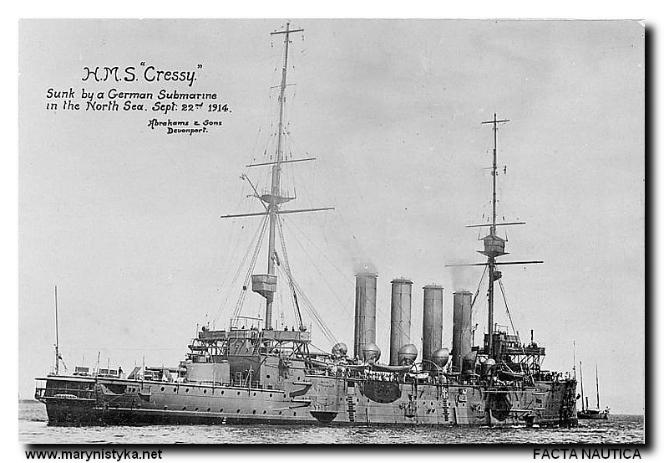Sunk Three Times in an Hour November 21, 2014
Author: Beach Combing | in : Contemporary , trackbackBeachcombing’s grandfather was sunk three times in the last World War. But the three times in question were spread out over seven years… Imagine, instead, being sunk three times in just under an hour, not only that, we are not talking about lonely frigates or minesweepers, these were three British battleships: HMS Cressy, Aboukir and Hogue. The three ships in question were, in autumn 1914, part of Cruiser Force C, the so-called live-bait squadron that ran up and down the North Sea between Germany and Britain. The British admiralty were worried about a German attack above water, no one seems to have taken the threat of submarines so very seriously. 22 Sept U9, a German submarine spotted Crecy, Aboukir and Hogue going at a modest speed and failing to zigzag, the classic avoidance technique even at this date for submarine attacks. At 6.25, U9 under its captain Otto Weddigen hit Aboukir. Hogue was dispatched with two torpedoes at about 7 while trying to rescue survivors from Aboukir. At 7.20 U9 shot two torpedoes at Cressy, one of which hit: a third torpedo then put the struggling battleship out of its misery. Of 2296 men on board the three vessels only 837 were rescued.
But hold on you might be saying, an impressive if ghastly feat on the part of u9 in an attack that might be said to have announced the onset of the submarine age. But this is three ships being sunk, not one man on three ships. Read, this, account though of one of the survivors, a British midshipsman, W. Wykham Musgrave from a letter home (25 Sept):
Dear Granny, I had a most thrilling experience. We were woken by a terrific crash and the whole ship shook. The Aboukir went down suddenly and we slid down her side into the water. I swam to the Hogue and was just going on board when she was struck and sank in three minutes. I then swam onto the Cressy where I had a cup of cocoa, but as I finished it [you have to be grateful for small mercies in the North Sea] she was struck. I jumped off again. I was picked up having been three hours in the water.
Thrilling experiences aside, W. Wykham Musgrave was extremely lucky to get back home. There must be many cases of being sunk twice in ten minutes where submarines are concerned: i.e. survivor climbs on to a rescue ship, only for the rescue ship to receive a torpedo in its guts. But can anyone else equal three or more ships? Drbeachcombing AT yahoo COM Musgrave is surely a candidate for the luckiest man in Royal Navy in World War One: memories of Gordon Selby, the luckiest man in World War 2.
29 Nov 2014: Louis an old friend of the blog writes, ‘Found the piece very interesting, but have to pick a nit: Although you describe the three (sister) ships as battleships, they were not. All three were what was called at the time “armoured cruisers”. As they were built before the Dreadnought, they were considered obsolescent by the time they were lost, as their armament, and armour, was not enough to stand in the line of battle, or fight with or against the new battlecruisers, which had more speed, and bigger guns, and also better armour.’ Thanks Louis!



